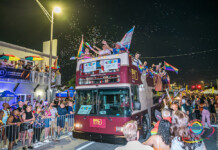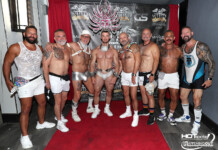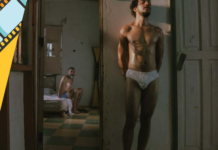LGBT History Month is a fairly new observance, first thought up by an enterprising Missouri schoolteacher. In 1994, Rodney Wilson, then 29 years old, came out to his students in St. Louis County, Missouri. After teaching his class about the Holocaust, he revealed that he too could have been killed by the Nazis, but not for his religion, for his sexuality. From there, the idea of LGBT History Month was born.
Wilson wanted to be able to inform students about the gay rights movement, how it related to civil rights movements in general, and about famous historical figures who excelled at everything from politics to medicine to athletics, and who just happened to be gay. Originally named Gay & Lesbian History Month, “Bisexual” was soon added to the title and eventually included transgender people as well with the inclusive “LGBT History Month” name. The National Education Association supported LGBT History Month at its general assembly in 1995.
Despite early progress, no state was ever mandated to teach children about LGBT history in its curriculum until California passed a bill in 2012 that insisted LGBT events and accomplishments be taught in the classroom. A similar bill has also been discussed in the Massachusetts Legislature. In 2012, two school systems recognized LGBT History Month for the first time: Broward County Schools in south Florida, and the Los Angeles Unified School District in California. In 2013, Palm Beach County Schools issued a proclamation recognizing LGBT History Month as well.
Throughout its history, LGBT History Month has been endorsed by Gay, Lesbian and Straight Education Network (GLSEN), GLAAD, the Human Rights Campaign, the National Gay and Lesbian Task Force, and various other organizations. In 2006, Equality Forum assumed responsibility for all promotional and content support LGBT History Month needs to be successful across America.
Ever since 2006, Equality Forum, via their website lgbthistorymonth.com has selected a yearly list of icons that teachers can share with their students, or LGBT media can share with their readers, so people can become more educated about today’s visible LGBT faces or the people who brought us to where we are today that we may not remember anymore.
Each week throughout the month of October, we will be profiling people from the Equality Forum LGBT History Month icons list who have made a positive impact in their chosen professions. This week, one person will be profiled, and two will be profiled each week thereafter through the end of the month. To see Equality Forum’s 2015 icons list, visit lgbthistorymonth.com.
Angelina Jolie
 Angelina Jolie was born into a showbiz family: her parents Jon Voight and Marcheline Bertrand were both actors. Watching movies with her mother influenced her decision to become an actress as well. She earned her first professional film role in 1993 at the age of 18, in a straight-to-video release called Cyborg 2. In 1995, she was cast in her first major Hollywood production, Hackers. She continued on with roles in a number of films that were critically acclaimed but not profitable.
Angelina Jolie was born into a showbiz family: her parents Jon Voight and Marcheline Bertrand were both actors. Watching movies with her mother influenced her decision to become an actress as well. She earned her first professional film role in 1993 at the age of 18, in a straight-to-video release called Cyborg 2. In 1995, she was cast in her first major Hollywood production, Hackers. She continued on with roles in a number of films that were critically acclaimed but not profitable.
In 1997, it was a surprise to many when the then-low-profile Angelina won a Golden Globe Award for her portrayal as Cornelia Wallace in TNT’s film George Wallace. From there, she was cast as the troubled model Gia Carangi in HBO’s film Gia. She won another Golden Globe, and for the first time, won a Screen Actors Guild Award. Angelina starred in three films in 1999; the last of the three, Girl, Interrupted, cemented her as an in-demand A-list actress, and she won an Academy Award for Best Supporting Actress.
She expanded her international profile with appearances in blockbuster films such as Gone in 60 Seconds (2000), Lara Croft: Tomb Raider (2001), and its sequel, Lara Croft Tomb Raider: The Cradle of Life (2003). Angelina starred with Brad Pitt in the film Mr. and Mrs. Smith in 2005; the film grossed nearly half a billion dollars worldwide and her chemistry with Pitt received rave reviews. It was during this film that the two would begin a love affair in real life, which endures today.
By the time she starred in the Daniel Pearl biopic A Mighty Heart in 2007, playing Pearl’s wife, she had become the highest-paid actress in Hollywood, routinely earning over $15 million for a single film role. She was nominated for an Academy Award for her role in the 2008 film Changeling, and received a Golden Globe nomination for the 2011 film In the Land of Blood and Honey, which was the first film she produced and directed.
Angelina would first become involved in humanitarian work in 2001, after seeing war-torn Cambodia, where she filmed her first Lara Croft movie. Since then, she has served as an ambassador for the United Nations High Commissioner for Refugees, visiting areas such as Afghanistan, Darfur, Colombia, and Syria.
Angelina identifies as bisexual, having first embarked on a love affair with a woman at age 20. As a result, she has spent much time advocating for LGBT rights, once famously promising not to marry her then-fiancé Brad Pitt until gay people could marry in the United States as well. Angelina and Brad (“Brangelina” as coined by the press) married in France in 2014.
Be sure to read all of our LGBT History Month profiles this October in the pages of Hotspots!














